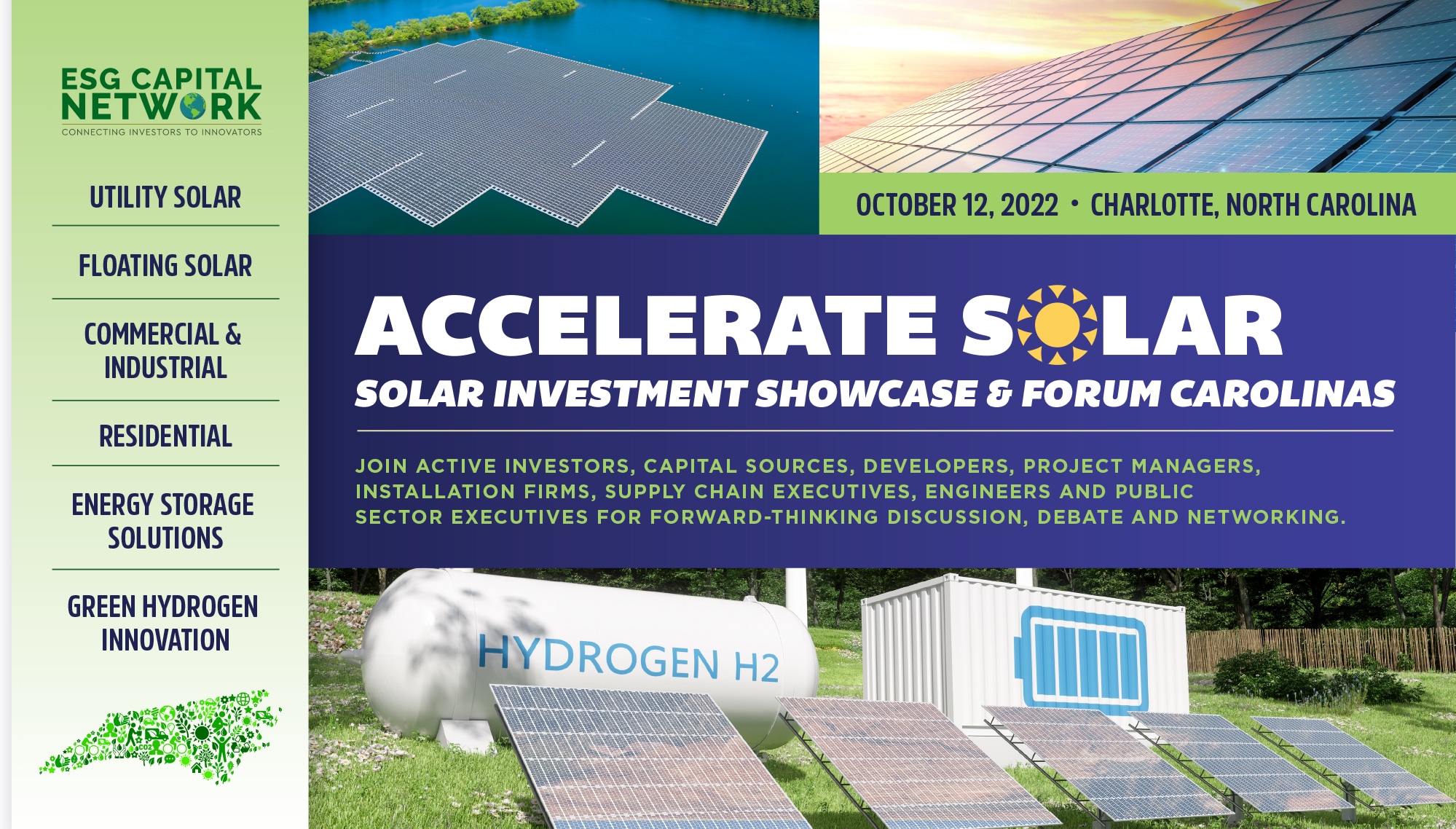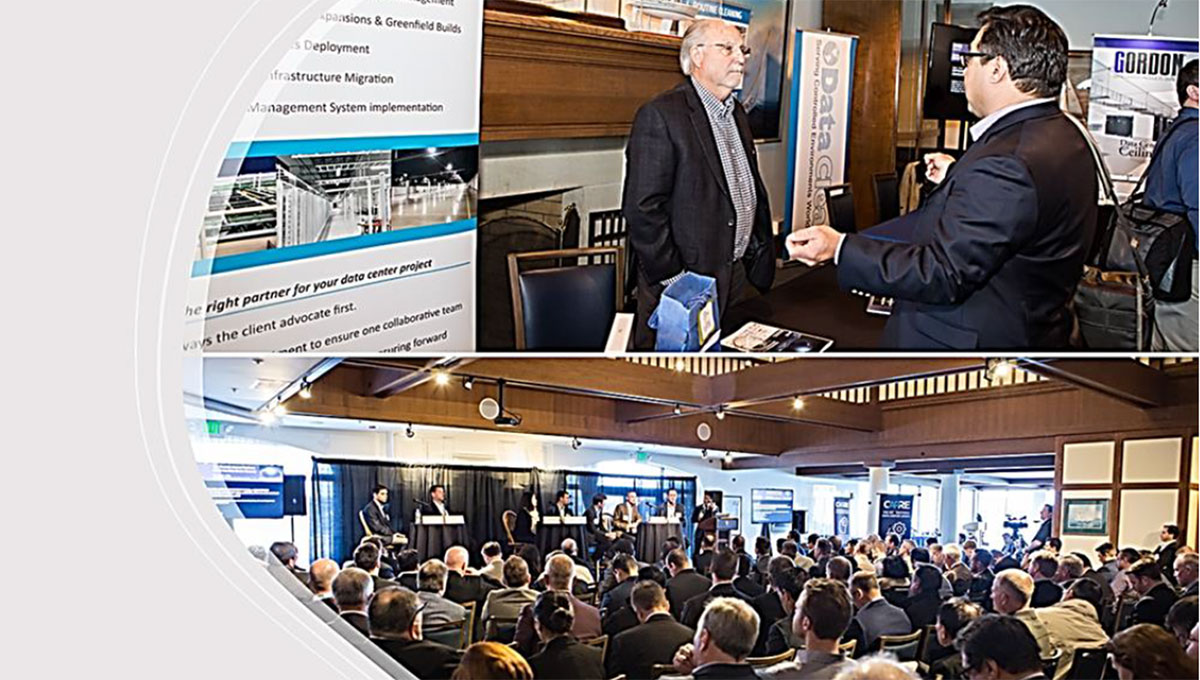
ACCELERATE SOLAR >>>
SOLAR INVESTMENT SHOWCASE & FORUM CAROLINAS
“SIS-CAROLINAS”
October 12, 2022
Charlotte Convention Center, Charlotte, NC
Welcome to the global energy transition! Connecting investors to innovators, ACCELERATE SOLAR, a division of the ESG CAPITAL NETWORK, will bring together innovation firms in photovoltaic development, solar panel installation, energy storage (ESS) arena as well as those driving change in power generation technologies, such as electrolyzers and green hydrogen. Indeed, the time has arrived for the acceleration of solar in the context of aggressive decarbonization goals. Institutional investors who represent the most active ESG private equity, hedge funds, high net-worth investors and pension funds will attend and participate.
Join industry leaders and innovators for vital discussion and networking in this high-level, business leisure gathering. What are the most applicable use cases of solar in utility, floating, C&I and portable as the planet shifts to decarbonization? How will the shift to carbon neutrality drive innovation and ROI in solar in the years ahead? The future of carbon neutrality and EV technology mandates are closer than most realize; the opportunities in solar and its supply chain are tremendous.
“We have this handy fusion reactor in the sky called the sun, you don’t have to do anything, it just works. It shows up every day.” — Elon Musk
SPEAKERS & ADVISORY BOARD



Stetson Tchividjian
Director Of Business Development
D3Energy, LLC
MARTY SUSZ
Director of Energy Management
Archdiocese of New York
ALI HUSAINAT, Ph.D.
Consultant
Texas Solar Energy



CHRIS KOENIG
Managing Partner
Pittsburg RV & Boat Storage, LLC
HAL SLATER
Owner
Slater Solar
STEPHEN ALMEIDA JR.
Member Board Of Directors
Fuel Cell & Hydrogen Energy Association (FCHEA)
Sponsors




Who will attend and participate?
ESG Capital Network will recruit core audience constituencies, in this priority:
1) Investors & Capital Sources:
Private equity, for example: KKR, Windmill Capital, GI Partners, Breakthrough Energy, etc.
Hedge Funds, i.e., Bridgewater Associates, Blackrock, etc.
High net worth investors and building owners (commercial, industrial, residential)
Debt sources, including banks
Crowdfunding and alternative capital sources
Pension funds
Other institutional investors from U.S. and globally
2) Commercial and industrial energy end users:
Military
Colleges/Universities
Manufacturing
Telecom
Healthcare Systems
Public Sector
Pharmaceutical
3) Engineering & Technology Firms:
Photovoltaic innovators, including engineers, architects and scientists
Green hydrogen executives
Battery/ESS (Energy Storage Systems) firms, such as Panasonic, LG, Samsung
4) Solar/Photovoltaic Installation firms and engineers
5) Utilities:
C-suite leadership from leading utilities, including ConEd, Com Ed, Duke Energy, SoCal Edison, etc.
6) Service providers:
Examples, including Lithium-ion mining firms, end of life battery recycling firms, transportation firms, etc.
7) Public sector executives:
Federal, state, regional executives who are looking to further energy transition, JV with private sector, or who may have unique
incentives, grants, debt programs available.

Proposed Agenda
| October 12, 2022 | Solar Investment Showcase Conference Topics |
| 7:30 a.m. | Coffee, Breakfast & Networking |
| 8:30 a.m. | Opening Remarks |
| 8:45 a.m. | Morning Keynote: View from the Public Sector on Incentives, Solar Acceleration & the Big Picture of Energy Transition In 2021, the U.S. government announced a new target to achieve 50-52% greenhouse gas pollution reduction of 2005 levels by 2030. This aggressive goal will accelerate green energy innovation and spark new jobs over the next eight years. The morning keynote will take a look at energy transition from federal, state and local perspectives, including incentives, grants and other monetization opportunities Proposed Discussion Points:
Proposed speakers:
|
| 9:15 a.m. | Utility Solar: Capital Raising, Investment, Project Development and ROI Analysis by Acreage and Megawatt Proposed Discussion Points:
|
| 10:00 a.m. | A Case Study in the Ubiquitous Nature of Solar: Photovoltaics and Boosting ROI through a Hybrid Business Model In this case study, an investor will discuss the application of solar panels in a commercial boat storage facility. Indeed, the traditional boat storage facility witnessed demand increase when the owner created covered storage using solar canopies that protect the sailing vessels from direct sun and adverse weather. Praised by the boat owners, the owner was able to produce dual income from boat storage and PV solar generation, which is sold back to the utility. The rental rates for boat storage increased with the solar canopy covering. Proposed Discussion Points:
* Chris Koenig, Managing Partner, Pittsburg RV & Boat Storage, LLC (tentative) |
| 10:20 a.m. | Networking Break |
| 10:50 a.m. | Portable Solar Monetization Opportunities: From Street Lighting, Military Operations to Remote Energy Storage, How is this Market Segment Accelerating on an Annual Basis? Solar is ubiquitous. As such, the portable solar market allows entrepreneurs to devise a a range of creative product innovations, from off-the grid street lighting, public sector and industrial products, military, emergency lighting and remote energy storage. Indeed, solar PV technology is even appearing in key chains and clothing, such as hats and t-shirts. In addition, innovators have devised flexible and unique panels designed to fit almost any situation. In this session, panelists will discuss the viability of the portable and retail solar markets, including: analysis of past growth, prior innovations and expectations for the future. Proposed Discussion Points:
|
| 11:20 a.m. | Opportunity Rising: The Growth of Floating Solar as an Innovative Alternative to Compete with Utility Solar in Terms of Power Generation and ROI for Investors and Developers Floating sell has emerged as one of the latest innovations in the photovoltaics arena with generation capacity on par with traditional utility scale, and serving as an option for municipalities that seek additional revenue streams and more resilient electrical grid systems. In this session, panelists will discuss the viability of floating as an effective power generation source that offers long-term ROI for investors. Proposed Discussion Points:
* Stetson Tchividjian, Director Of Business Development, D3Energy, LLC (tentative) |
| 11:50 a.m. | Networking Break |
| Noon | Keynote Presentation: Full Electrification: Opportunity for Solar Companies Proposed Discussion Points:
* Hal Slater, Owner, Slater Solar (tentative) |
| 12:20 p.m. | Carolina Commercial & Industrial Solar Development, Installation and Technology Upgrades: The Outlook for this Diverse Market over the Next 2-5 Years Commercial and industrial building solar investment offers some of the highest returns in the photovoltaic arena. Often considered 'power plants on the roof,' this market segment is rapidly growing with logistics owners and operators such as Prologis, Amazon Distribution, FedEx, UPS adopting net-metering strategies to lower costs and boost ancillary income. Proposed Discussion Points:
|
| 1:00 p.m. | Networking Luncheon |
| 1:30 p.m. | Luncheon Keynote: The Play of Solar Photovoltaics in the Rapid Growth of E-Mobility E-Mobility is defined as 1) Fleet operations (logistics: FedEx, UPS, utility trucks, public sector vehicles), 2) Heavy duty trucking, 3) Mass transit, 3) Traditional EV (cars), 6) Marine, and 7) Aviation. In this session, solar photovoltaic and e-mobility executives will discuss the rapid ramp-up in infrastructure improvements in the coming decade, and opportunities for investors, capital sources, project developers and solar installation firms. Proposed Discussion Points:
|
| 2:00 p.m. | Acceleration of Solar Innovation from an Engineering Perspective: How Future Photovoltaic Cells May Yield Greater Power Density and Higher Returns Proposed Discussion Points:
|
| 2:30 p.m. | Net Metering 101: An Industry Update from a Major Utility Description/Discussion Points TBA |
| 3:00 p.m. | Networking Break |
| 3:15 p.m. | Inside the World of Energy Storage Systems: Investment, Engineering, Architecture and Innovation Innovation in energy storage in tandem with PV engineering and installation will be vital for future growth and ROI. In this session, hear from innovators who will change the ways in which energy is stored in the coming years. Proposed Discussion Points:
|
| 4:15 p.m. | The Green Hydrogen Roundtable & Cocktail Reception To conclude SIS CAROLINA, hear from experts on the next chapter in the acceleration of solar, green hydrogen. North Carolina might win one of four bids for $8 bn in infrastructure for hydrogen hubs in the Why might Carolinas win 1 of 4 bids for $8bn in infrastructure for hydrogen hubs in Infrastructure Investment and Jobs Act. Department of Energy is instructed to create 4-8 hubs in the United States. Specifically, experts will discuss:
* Stephen Almeida, Jr., Member Board Of Directors , Fuel Cell & Hydrogen Energy Association (FCHEA) |
| 7:15 p.m. | Event concludes/Closing Remarks |
| Time TBA | Residential Market Outlook: Analysis of Homeowner Trends, Impact of Incentives and Innovation in Design Proposed Discussion Points:
|
| Time TBA | Accelerate Solar Innovation Awards Proposed Awards:
|